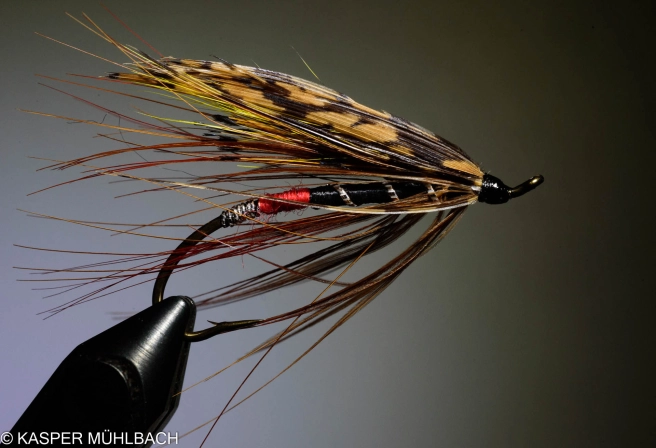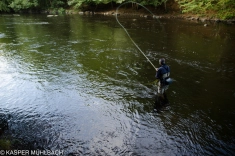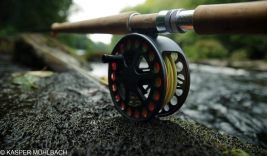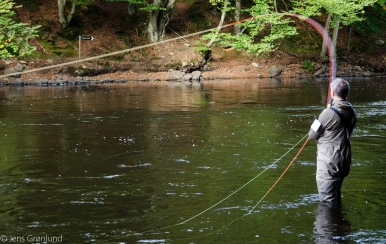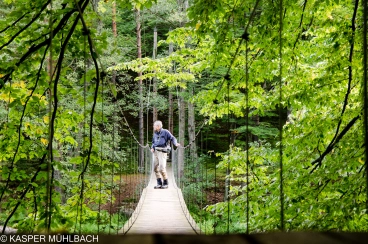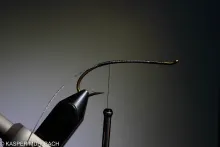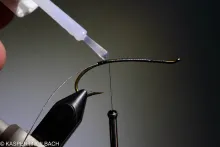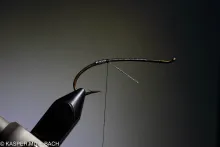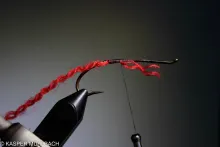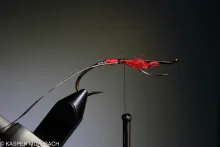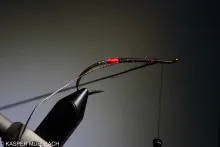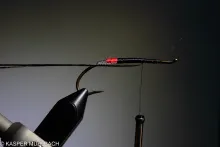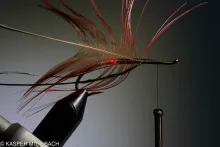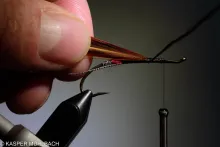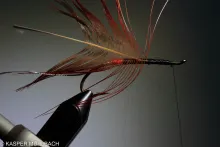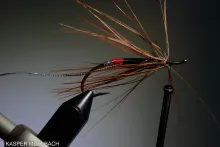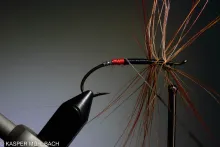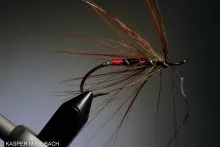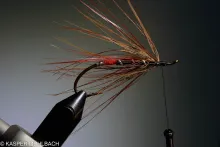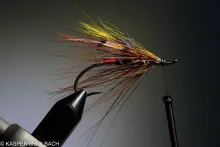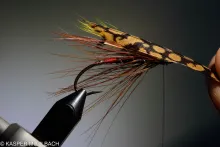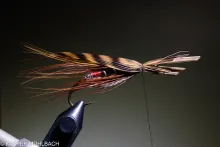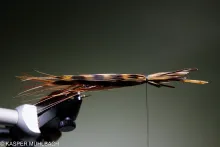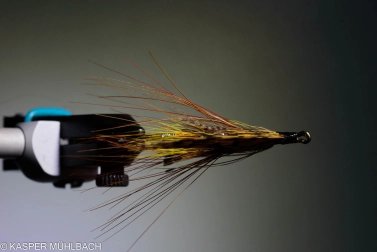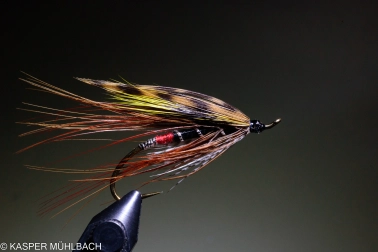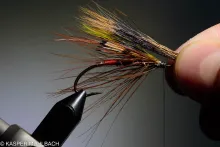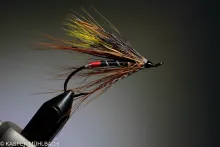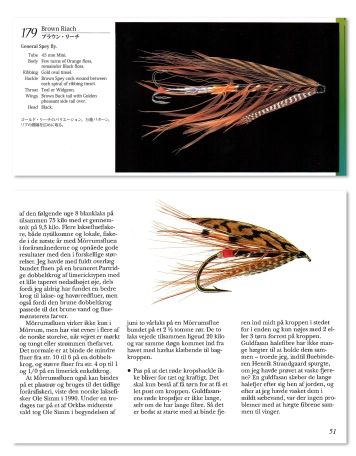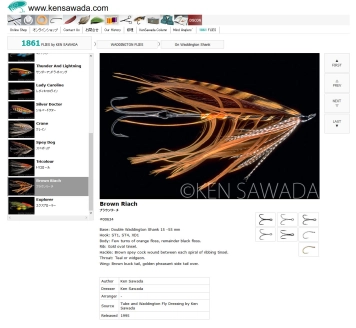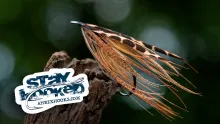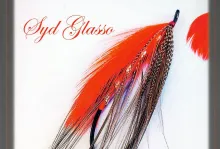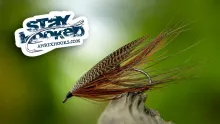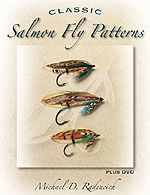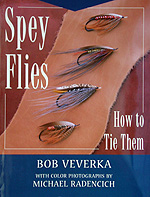The Mörrum fly has been named after the south Swedish river Mörrum, but is also sometimes referred to as The Grünewalder after its originator, Danish Jan Grünwald
In 1994 the Danish fly-fishing pioneer Jan Grünwald published the fly his book "Dangerous Flies for Salmon" (Farlige Laksefluer, available in Danish only), but I think I saw the Mörrum Fly somewhere else in the late 80’s or early 90’s.
I liked the colors
and it turned out that my granddad had a complete golden pheasant skin at his tying place, from which I borrowed some feathers.
I tied just a few for river fishing for sea trout. I tied them on a size 6 hook which was a surprisingly big fly for my granddad, so he did not want to have one but stuck to his much smaller red Chillimps-like flies.
It was late September
and it had been raining for days. The river was coming up and so were the sea trout. At that time I was 99.9% into dry fly fishing, and did not pay much attention to sea trout. But spending time with the old man was definitely quality time, and we enjoyed being at the river bank. The moisture from the rain filled the air and the fields were breathing mist as the sun slowly made its way behind the tree tops.
We hadn’t been fishing for long
before granddad hooked a nice 3 kilo sea trout, and we saw more coming upstream, so he did not move many inches out of his spot that evening.
I went a few hundred meters downstream. It is a lovely stretch with holes, deep banks and the river making its way to the ocean meandering from right to left and back again.
I approached a spot
where I had seen some sea trout two years earlier. Slowly, and trying to be stealth, I watched the water. No signs of life. The light was kind of warm and the water brownish. I tied on the Mörrum Fly as it showed the same nuances. It looked nice – but would a sea trout notice that? Why should it? The fly did not look provocative. Neither did it imitate anything. That's sea trout fishing...
Kasper Mühlbach
What I didn’t know
at the time was that Jan Grünwald's thoughts behind the fly were strongly inspired by the large stonefly found in and along the banks of Mörrum during the Swedish summers.
Well, the first time the fly swung over the spot, I rose a fish, and the second time I also hooked it. My first sea trout on the fly, and a beautiful female just between 2.5 and 3 kilos. Wow!
I was so happy
when realized that sea trout fishing in rivers was pretty easy.
The next couple of years proved me so wrong!
That river was the only one I fished for many years, and I tried many flies but for some unknown reason the only fly with which I could tempt the sea trout was the Mörrum Fly.
Jan Grünwald introduces
the fly like this:
The water in the River Mörrum is humus-colored (peaty), but clear most of the time, enabling you to see the bottom clearly when you wade into the water.
For the clear, peaty water I found the Ullsock to be too dark and gloomy in many cases while the hot-headed orange GP had too much of an effect. I missed a fly right in between, and during the winter of 1982 I tied the Mörrum Fly, which contains elements from both flies.
In the river Spey on Scotland, I had seen how delicate a long and sparse spey hackle pulsated in the current and after several attempts I found a red body feather from a golden pheasant would do the job.
The wing was made from brown-black spotted tail fibers from the golden pheasant, and was chosen to imitate the wing from the big stonefly, which can grow as big as a little finger, and sometimes hatch in ten of thousands in May and June.
It has red legs, a brown body and flat dotted wings in black and brown. Trout, small salmon and smolt go crazy when the stoneflies hatch, and if the big bright salmon has some sort of memory of its early years in the river, as claimed by some people, it cannot be a bad idea to imitate this tasty morsel.
Featuring a flat brown and black wing over a body with red legs, the Mörrum Fly is not a bad imitation of the big stonefly.
The fly hooked my biggest salmon in May 1983 and was responsible for eight bright salmon weighing 75 kilos or 165 lbs altogether.
In Sweden
the Mörrum Fly now has the nickname The Grünewalder, and has become a classic in peaty Scandinavian waters.
Tying tips
To make the fly perfect the wing should be tied spey style, lying flat over the underwing as a roof.
The body hackle should be sparse and wrapped maximum 2-3 times over the body.
Tips from Jan Grünwald
I talked to Jan while writing the article, and he added these notes to the pattern and the tying sequence:
To imitate the bright red legs of the big stone fly it may be even better to use a pheasant body feather dyed hot red.
The butt was originally magenta.
Folding the wing is a challenge. The tail fibers from the GP does not stick together well, and a better result may be obtained if the feather is washed gently or steamed.
The shape of the wing needs support, and a bunch of squirrel hair makes it easier to fold a flat, spey-style wing.
The preferred hook was originally a bronze Partridge double trout hook.
Tying instructions
Click on each image for a larger view and details on the tying.
|
|
|
|
|
|
|
|
|
|
|
|
|
|
|
|
|
|
|
|
|
|
|
|
|
|
|
|
With a hair wing
You can tie the fly with a hair wing. Use barred hair if possible, like squirrel or silver fox and select a dark hue if possible, maybe even dyed dark brown.
The hair wing version can be used if you find the golden pheasant tail feather wing too challenging. It can be difficult getting a suitable pair of tail feathers (you need a left and right feather) of the right quality and length where the fibers have not been destroyed because of the pheasant trailing the tail through dirt and gravel.
Furthermore, a hair wing will be cheaper, probably last longer and will be more mobile in the water. However, it does not give you the impression of a stone fly wing or give you a fly in the classic Spey style.
Some sources
To the right you see two excerpts from a couple of books. On the top it's Japanese Ken Sawada's Waddington shank called the Brown Riach, which is surprisingly similar to Grünwald's Mörrum Fly, seen in the lower section, which is a facsimile of the page from Grünwald's book "Farlige Laksefluer" in Danish.
We do not intend to accuse any of these gentlemen of copying each other, but just noticed the great similarity. Grünwald's fly is most likely earlier than Sawada's.
Below you see the same fly from Ken Sawada's current web site.
- Log in to post comments

